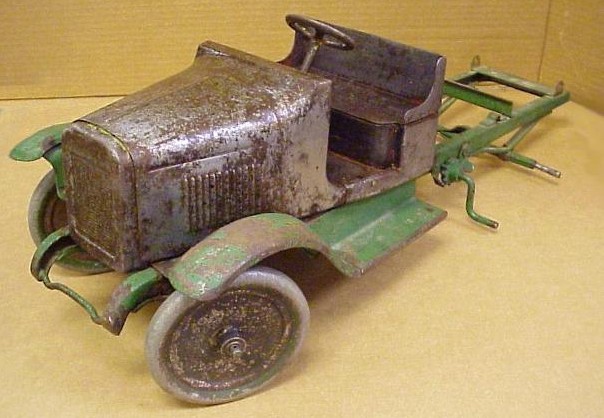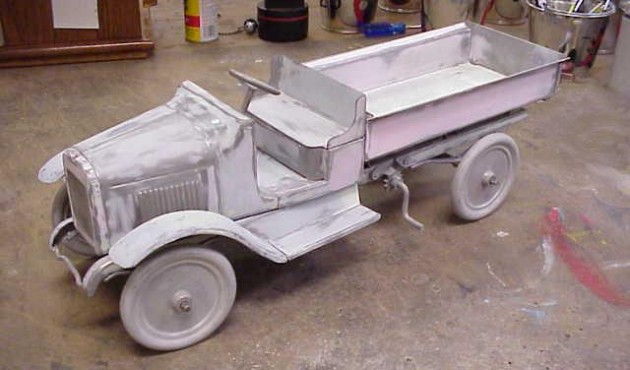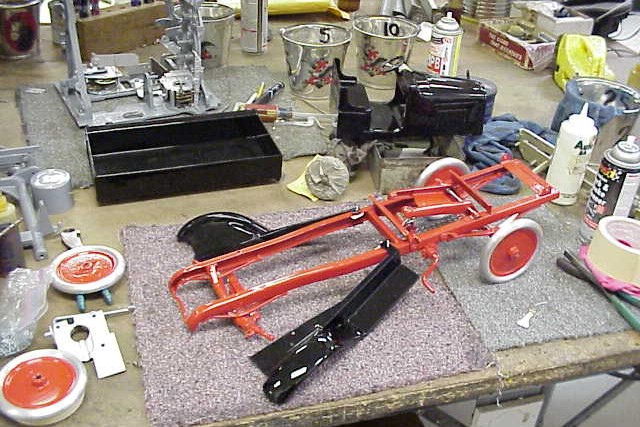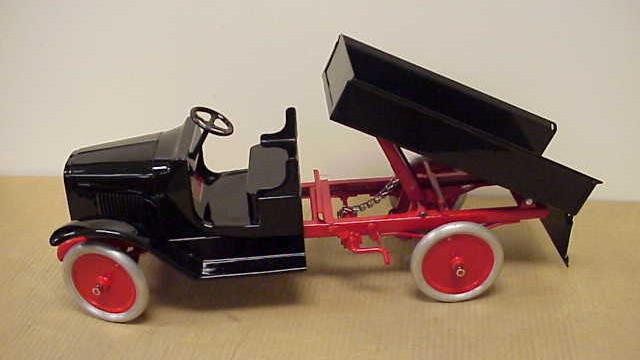Vintage trucks for restoration come in all sizes. Shown here is a vintage pressed-steel toy truck, manufactured in the 1930s by a company called ‘Buddy L’.
The ‘before’ version has been overpainted several times, green over rust and black, and lots of dents. The first stage of the restoration involved the use of a Dremel tool to grind away the rivets holding it together. Many hours were then spent with a body hammer, flat punches, and a home-made wooden tool formed as a dolly to shape the crowns of the fenders.
Regular auto body glaze was used to fix the imperfections. Lots and lots of sanding by hand were to follow.
Here it is in completed mock-up assembly, checking for the same things as on a “real” car, panel straightness, alignment, and general fit. Nothing is worse than freshly painted parts that cannot be installed because they don’t fit after many hours of hammering, welding, filler application, sanding and shaping.
Here are the parts freshly sprayed with regular automotive basecoat-clearcoat paint.
This is the finished product. It measures 24 inches long. The crank handle shown on the frame is to raise the dump bed with a chain lift sprocket. It rolls and the steering wheel turns the front wheels. Too bad I can’t actually haul anything with it…







Marty, that’s absolutely stunning! Great work!!!! That’s one restoration that I’m sure is ‘better than factory’!
Beautiful job!
Marty, your work is beautiful! Is there any chance you could share how to upload more than one picture to this site?
you ruined it, sadly. all that patina, age and human handling…gone. i guess one can appreciate your effort, but as an antique dealer i’m sad to see it turned into just another shiny toy.
Wonderful restoration. Buddy L’s are sought after toys. I wonder if the restoration hurts it’s market value?
Wow…and wow again…great story…great job!!!
ALL restored toys have diminished values compared to originals. That’s because most restorations are not 100% faithful to the originals. Some people, like myself, collect only mint, pristine examples, and my restorations reflect that ethic. Others prefer toys in “as found” condition, even rusty, dented, warped, missing paint or parts or both, etc. It’s the same reason I could never understand coin collectors. Old, dirty coins are worth more than when they’re professionally cleaned and show their original patina.
Dommage de restaurer ce mini trucks , sa peinture verte etait pas mal …
Very nice find! Great restoration!
Nice work, you have way more patience than I do working with small pieces like that.
High quality work, but I think it really looked better in the original used patina.
Thank you all for the compliments and criticisms. To those who expressed concern, I have several other trucks like this that are in original condition, and I would never consider painting or restoring them. This one was a little more rough than the first photo shows. Every panel except the hood and cowl was bent (some of the straightening had already been done by the time of the first photo), both sides of the bed, the bottom, and missing tailgate. It had a small rust hole in the bottom of the bed and even the frame was bent in the middle, likely from a child sitting or standing on it at some point. It was more mangled than it looked, and all of it covered with a heavy coat of green paint. The amount of filler required to get it straight, is shown in the second photo and should provide a better idea of what I started with than the first photo does. But again, I have others with original paint, dents, rust, and so on…that will always remain that way. Thanks again for all of your comments.
Jason, I don’t know of any way to upload more than one photo in the comments section. I recommend either one at a time, or send multiple photos to the editors. In which case it’s possible they could become a feature! Also, clear up one thing please; you said you only collect mint, pristine examples…but your restorations reflect that ethic?
Marty this is a 1920’s buddy L & great work. Your right some times there just to far gone or some one has started them already..
That’s really cool. Better than new!
Marty, I agree with what you’ve done with this truck. I have a small collection of Tonkas from the ’50s and early ’60s. One truck was so beat up I restored it to resemble my full size driver. I also have one Buddly L and one Tonka that are 53 years old and are still in the original boxes and have never been opened. It just depends what condition they’re in when you find them as to what you do with them.
1963 Tonka and 1965 Buddy L
‘Buddy L’ toys were manufactured in Moline, IL ( 61265) on a hill just above the Mississippi River. The plant has been gone for more than 30 years.
Unfortunately toys are fun to have, but are not a good investment …
Actually there is a large toy collecting community and some toys do hold their value well. People who do not follow toy collecting will be surprised at how big this hobby is. Look up Buddy L, Tonka, Nylint, and a few others on ebay. Then watch the unbelievable prices some of these items sell for. Items made in the 30’s such as this truck command good prices.
A few years ago there was a seller who found a 1964 Nylint mobile home and Ford truck that was in the original carton, never unwrapped or played with. The mobile home came with doll house furniture in it which was still in the original plastic bags. This item sold for $1800.00 and the bidding was fierce.
http://tse1.mm.bing.net/th?&id=OIP.M294c0080a4055291a064f726401c643do0&w=278&h=171&c=0&pid=1.9&rs=0&p=0&r=0&url=http%3A%2F%2Fwww.ebay.com.au%2Fitm%2FVintage-Nylint-Pressed-Steel-Ford-Mobile-Home-Truck-in-Original-Box-No-6601-%2F221704561057
maybe i guess i wont restore mine it s just like that stock original
really u haven t been keeping up on some of these 1000.00 toys then
As a toy train collector the big question is always when it is appropriate to restore a toy. Other toys are valued by the same criteria. I have restored a couple of 1940’s Lionel locomotives that are so common that they don’t command high prices. Just like cars these same trains in number 1 condition with the boxes command a good price compared to the ones that have been played with. These locomotives serve on my train layout and are work-horses. The grandchildren routinely play with them, and general wear and tear is acceptable.
We have a couple of trains from the 1920’s that are like new with the original boxes, and of course those are mostly displayed in a glass cabinet. I run everything that I own, so even the pristine old timers see some track time.
I have one train set from 1927 that has been played with a lot. The set shows quite a bit of wear and tear. The set would be difficult to restore since the decoration is what is known as tin lithography. The body of the train is painted with rivet details, indentions, door latches and other details not molded into the metal, but painted on. There are professionals who restore such items, however the cost is high. The primary reason that we chose not to restore this item is that it belonged to my uncle who was given the train at age 2 in 1927. He developed a blood infection at age 7 in 1932 and passed away that year. My dad was born the same year. The train was passed on to the other children in the family and they all played with it over the years. So this forlorn train with its patina has a prime spot on the mantel over our fireplace due to the fact that each scratch is part of our family history. The train has little resale value due condition and to the fact that it was a common item and this model is plentiful even today. However the same train set in pristine condition commands a good price.
Great restoration. Don’t listen to the nay-sayers.
I have two trucks that I’m trying to make one, and would like to know where you get the rivets For the frame and body